|
Boletín de la Sociedad Geológica Mexicana Volumen 74, núm. 2, A020122, 2022 http://dx.doi.org/10.18268/BSGM2022v74n2a020122
|
 |
Paleoecology of Lower Miocene coralline red algae-rich grainstone facies in the Qom Formation (Vartun section, central Iran)
Paleoecología de la facies grainstone rica en algas rojas coralinas del Mioceno Inferior de la Formación Qom (sección Vartun, Irán central)
Amir Hossein Rahiminejad1,*, Mehdi Yazdi2, Amit Kumar Ghosh3
1 Department of Ecology, Institute of Science and High Technology and Environmental Sciences, University of Advanced Technology, Kerman, Iran.
2 Department of Geology, Faculty of Sciences, University of Isfahan, Isfahan 81746-73441, Iran.
3 Birbal Sahni Institute of Palaeosciences, 53 University Road, Lucknow-226 007, Uttar Pradesh, India.
* Corresponding author: (A.H. Rahiminejad) This email address is being protected from spambots. You need JavaScript enabled to view it.
How to cite this article:
Rahiminejad, A.H., Yazdi, M., Ghosh, A.K., 2022, Paleoecology of Lower Miocene coralline red algae-rich grainstone facies in the Qom Formation (Vartun section, central Iran): Boletín de la Sociedad Geológica Mexicana, 74 (2), A020122. http://dx.doi.org/10.18268/BSGM2022v74n2a020122
Manuscript received: November 18, 2021; Corrected manuscript received: December 10, 2021; Manuscript accepted: December 27, 2021.
ABSTRACT
In this paleoecological study we focused on coralline red algae-rich shoal grainstone facies in the Lower Miocene (Aquitanian) carbonates of the Qom Formation in the Vartun section in central Iran. The identified coralline red algae are mainly non-geniculate, although very rare geniculate forms of corallines were also recognized in thin section analysis. The identified algae are represented by Melobesioideae (Lithothamnion cf. valens, Lithothamnion cf. rovereoti, Lithothamnion cf. peleense, and Lithothamnion spp.), Mastophoroideae (Neogoniolithon sp., Spongites spp., and Spongites cf. fruticulosus), Sporolithon spp. (Sporolithon spp. and Sporolithon cf. airoldii), and geniculate coralline (Corallina). The algal taxa mainly display fruticose and lumpy growth forms. The dominance of the former is consistent with high water energy in the identified shoal environment. The presence of Lower Miocene algae indicates that deposition of carbonates took place in warm tropical to subtropical waters in a euphotic marine environment during the Aquitanian. Likewise, high water energy and sediment agitation resulted in taphonomic features such as fragmentation, abrasion, and disarticulation.
Keywords: red algae, rhodophyta, carbonate producers, facies, Miocene, Aquitanian.
RESUMEN
En este estudio paleoecológico se enfocó en las facies grainstone rica en algas rojas coralinas en los carbonatos del Mioceno Inferior (Aquitaniano) de la Formación Qom en la sección Vartun del centro de Irán. Las algas rojas coralinas identificadas en las facies son principalmente no geniculadas, aunque también se caracterizaron formas geniculadas mediante análisis de láminas delgadas. Las algas identificadas están representadas por Melobesioidea (Lithothamnion cf. valens, Lithothamnion cf. rovereoti, Lithothamnion cf. peleense, y Lithothamnion spp.), Mastophoroidea (Neogoniolithon sp., Spongites spp., y Spongites cf. fruticulosus), Sporolithon spp (Sporolithon spp. y Sporolithon cf. airoldii), y por coralinas geniculadas (Corallina). Los taxones de algas muestran principalmente formas grandes y grumosas de fructicoso. Donde predomina consistentemente con alta energía del agua en el ambiente arrecifal identificado. La presencia de algas del Mioceno Inferior indica que la exposición de carbonatos tuvo lugar en aguas cálidas tropicales a subtropicales en la zona eufótica marina durante el Aquitaniano. Asimismo, tanto la alta energía del agua como la agitación de los sedimentos, dieron lugar a características tafonómicas tales como fragmentación, abrasión, y desarticulación.
Palabras clave: algas rojas, rhodophyta, productoras de carbonato, facies, Mioceno, Aquitaniano.
- Introduction
Coralline red algae were one of the major components of calcareous benthic communities, reef builders, and carbonate producers in the Miocene shallow marine paleoenvironments (Halfar and Mutti, 2005; Braga et al., 2010; Sarkar and Ghosh, 2015; Sarkar et al., 2016). Several of the reported genera of coralline red algae in Miocene deposits encompass still living species and constitute a useful tool for paleoenvironmental interpretations (Braga et al., 2010), since they are good indicators of water depth, temperature, light intensity, and hydrodynamic energy of carbonate paleoenvironments (Bosence, 1991; Aguirre et al., 2000; Brandano et al., 2005; Braga et al., 2010).
Generally, the Oligocene–Miocene carbonate paleoenvironments represent the highest diversity of coralline red algae in the geologic record (Aguirre et al., 2000; Braga et al., 2010), with its maximum levels of diversity recorded in the Lower Miocene (Aquitanian) and represented by 245 species (Aguirre et al., 2000; Braga et al., 2010). Mainly, non-geniculate coralline red algae were dominant in the Miocene paleoenvironments, whereas, geniculate corallines were subordinate (e.g. Ghosh, 2002; Rösler et al., 2015; Coletti et al., 2018; Roozpeykar et al., 2019a).
The carbonate facies of the Qom and Asmari formations in central Iran and the Zagros Basin are the principal deposits of Miocene coralline red algae in Iran (Zabihi Zoeram et al., 2014; Roozpeykar et al., 2019a). This paper focuses on the paleoecological aspects of Lower Miocene coralline red algae from the Qom Formation and contributes data from the algal-rich Cenozoic carbonates of Iran.
- Geological Setting
In the present study, samples yielding fossil coralline red algae were collected from the Lower Miocene Qom Formation in the Vartun section (Figures 1 and 2). This section is located about 50 km northeast of the city of Esfahan (32° 56′ 13.79″ N and 52° 08′ 45.32″ E; Figure 1) and is situated in the north of the Esfahan–Sirjan fore-arc basin in central Iran (Figure 1A). The most exposed strata in the studied area comprise Quaternary terraces in addition to Triassic (massive dolomite, dolomitic limestone, limestone, shale), Jurassic (sandy shale, sandstone, conglomerate), and Oligocene–Miocene deposits (Figure 1C). Strata of the Qom Formation were deposited on the northeastern edge of the Tethyan Seaway in the Sanandaj–Sirjan fore-arc basin, and/or Esfahan–Sirjan fore-arc basin, and the Urumieh–Dokhtar magmatic arc basin in central Iran during the last marine transgression in the Oligo–Miocene (Daneshian and Ramezani Dana, 2007; Reuter et al., 2009; Zágoršek et al., 2017).
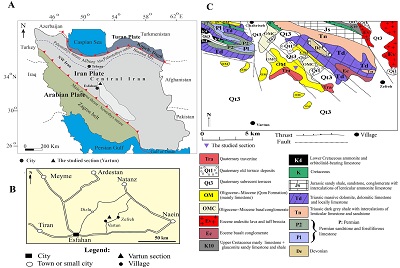 |
| Figure 1. (A) Geological and structural map of Iran and location of the studied section (Vartun section) in the north of the Esfahan–Sirjan Basin in central Iran (modified from Rahiminejad and Hassani, 2016; Rahiminejad et al., 2017, 2018; Rahiminejad and Zand-Moghadam, 2018, 2020; Moosavizadeh et al., 2020). (B) Location map of the Vartun section (modified from Zágoršek et al., 2017). (C) Geological map of the studied area (redrawn and modified from Zahedi, 1978 and Rahiminejad et al., 2020). |
Generally, the Oligocene and Miocene deposits of the Qom Formation in central Iran consist mainly of limestone, marl, gypsum, and subordinate siliciclastic sediments containing diverse fossil invertebrates represented by corals, gastropods, echinoids, bivalves (particularly pectinids), and coralline red algae (Seyrafian and Toraby, 2005; Reuter et al., 2009; Yazdi et al., 2012; Rahiminejad et al., 2020). These unconformably overlie the continental rocks of the Lower Red Formation (Oligocene) and are unconformably overlain by the Middle to Upper Miocene continental strata of the Upper Red Formation (Stöcklin and Setudehina, 1991; Yazdi- Moghadam, 2011; Amirshahkarami and Karavan, 2015; Rahiminejad et al., 2020). The depositional environments of the Qom Formation in the Esfahan–Sirjan Basin are consistent with mixed carbonate–siliciclastic homoclinal ramp (Reuter et al., 2009), open shelf (SE Chahriseh (Moradi, 2012)), and inner and middle ramps Vartun section (Rahiminejad et al., 2020).
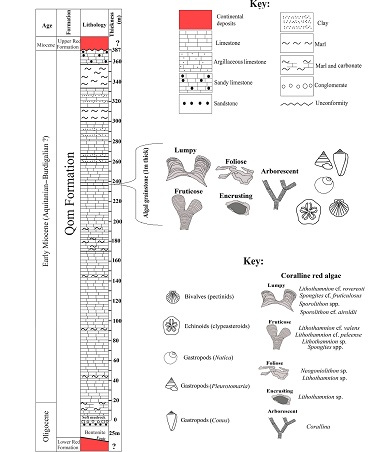 |
| Figure 2. Measured stratigraphic column of the Qom Formation in the Vartun section. Age of the Qom Formation in the section is based on Rahiminejad et al., 2020. Our studies focused on a 1 m-thick interval algal limestone comprising coralline red algae-rich grainstone. The symbols illustrating the growth forms of the identified algae are redrawn and modified from Woelkerling et al., (1993), and Nebelsick and Bassi (2000). The percentage or relative abundance of different algal growth forms in the studied grainstone facies is as follows: fruticose: 70 %, lumpy: 20%, foliose, encrusting, and arborescent: 10%. |
- Materials and Methods
The investigation of fossil coralline red algae and their associated facies or sedimentary texture was based on microscopic analyses of thin-section slides from thirty rock samples of algal limestone that were examined with a Stereo binocular Microscope model Yaxun YX AK21 and photographed using a CCD digital camera model KECam. The classification of carbonate facies followed that of Dunham (1962) and Flügel (2010), which is based on the types and abundance of grains and the matrix in the deposits. Taxonomic analysis of the identified coralline red algae was based on Braga (2003), Brandano and Piller (2010), and Sarkar (2017). Coralline red algal growth forms were described according to Woelkerling et al. (1993), and Nebelsick and Bassi (2000).
Since the collected algal specimens in the studied section are present as bioclasts and partially preserved fossils, confirmation of taxa at the species level cannot be accurately established. However, detailed statistical analyses on well-preserved algal samples may improve paleoecological interpretation in future studies.
The age of the Qom Formation in the Vartun section (Figures 1 and 2) is based on previous studies carried out by Rahiminejad et al. (2020) (Figure 3).
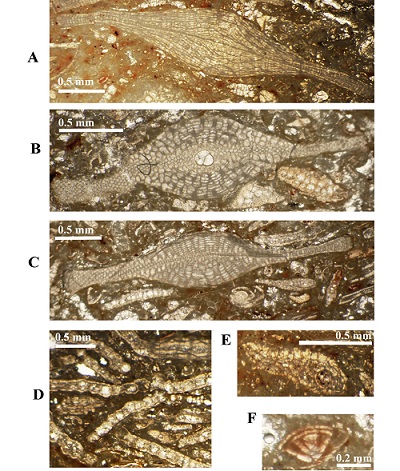 |
| Figure 3. Some of the identified large benthic foraminifera used for age determination of the Qom Formation in the Vartun section (Rahiminejad et al., 2020). (A) Lepidocyclina sp., (B) Nephrolepidina sp., (C) Eulepidina sp., (D) Operculina spp., (E) Miogypsina sp., (F) Amphistegina sp. Note that these microfossil specimens were not collected from the algal grainstone facies in this study. |
- Results
4.1. STRATIGRAPHY AND FACIES ANALYSIS OF THE STUDIED ALGAE-RICH LIMESTONE
We focused our paleoecological studies on a 1 m thick interval of Lower Miocene (Aquitanian) massive and lithified coralline red algae-rich limestone in the Qom Formation (Figures 2 and 4). The stratigraphic details of the Qom Formation in the studied section are shown in Figure 2. In the field, the limestone interval (Figures 2 and 4) is laterally exposed up to ca 70 m, is discontinuous, and untraceable in a wide area. Cylindrical Skolithos burrows are common and fossils of bivalves (pectinids), gastropods (Conus, Natica, and Pleurotomaria), and echinoids (Clypeasteroids) are abundant in the interval (Figure 2). Likewise, the limestone interval is composed of coralline algae-rich grainstone facies dominated by skeletal grains embedded in a sparitic matrix or sparry cement (Figures 5A and 5B). The latter (65%) include coarse-grained bioclasts and partially preserved specimens of abundant coralline red algae. Coarse-grained bioclasts of corals, echinoids, gastropods, and bivalves (22%) as well as scarce (13%) larger benthic foraminifera (Nephrolepidina sp., Amphistegina sp., and miliolids) comprise the subordinate skeletal grains.
 |
| Figure 4. (A) Outcrop view of the studied coralline red algae-rich limestone (1 m thick) in a grainstone facies. (B) Rock sample of the studied algae-rich limestone. |
4.2. THE IDENTIFIED CORALLINE RED ALGAE AND THEIR GROWTH FORMS
The micropaleontological studies revealed the presence of five genera of coralline red algae in the studied grainstone facies (Table 1 and Figures 5 to 8). Non-geniculate forms of the identified algae predominate (Table 1), whereas algae representative of geniculate forms (genus Corallina) are scarce. Several of the non-geniculate algae are highly fragmented and abraded, while geniculate forms are disarticulated and fragmented. The percentage or relative abundance of the algae is indicated in Table 1. The non-geniculate algae include melobesioids, mastophoroids, and sporolithaceans (Table 1). Melobesioids comprise the taxa Lithothamnion cf. valens, Lithothamnion cf. rovereoti, Lithothamnion cf. peleense, and Lithothamnion spp. Mastophoroids are represented by the taxa Neogoniolithon sp., Spongites cf. fruticulosus, and Spongites spp. Sporolithaceans include the taxa Sporolithon spp., and Sporolithon cf. airoldii.
| Table 1. The identified coralline red algae and their growth forms in the algal grainstone facies. The algae are dominated by non-geniculate forms. Geniculate forms (Corallina sp.) of the algae are scarce. The percentage or relative abundance of different growth forms of the algae in the studied grainstone facies is as follows: fruticose: 70 %, lumpy: 20% foliose, encrusting, and arborescent: 10%. |
 |
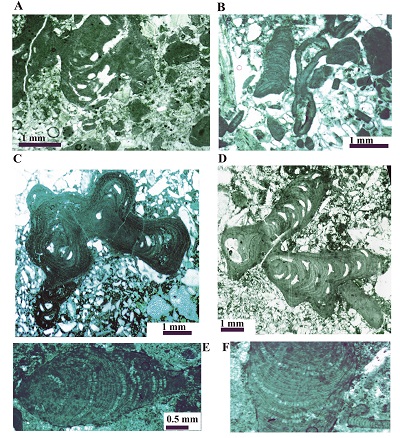 |
| Figure 5. (A, B) Algal grainstone facies. (C–F) Identified coralline red algae in grainstone facies; (C) Fruticose thallus of Spongites sp.; (D) Lumpy thallus of Spongites cf. fruticulosus; (E, F) Lumpy thalli of Sporolithon cf. airoldii. |
In the studied grainstone facies, the identified coralline red algae mainly display fruticose (70 %) and lumpy (20%) growth forms (Table 1). Algae with foliose, encrusting, and arborescent growth forms are also present (Table 1), although subordinately (10%).
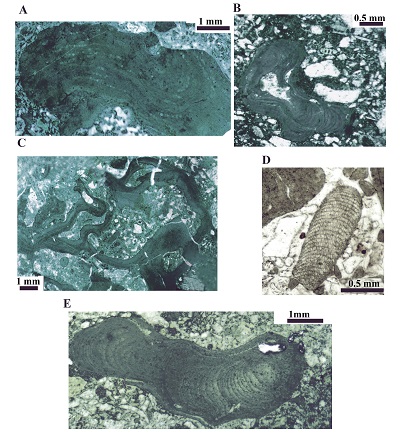 |
| Figure 6. Identified coralline red algae in the grainstone facies. (A) Fragment of Sporolithon sp. showing a lumpy growth form. (B) Fragment of a fruticose thallus of a melobesioid. (C) Foliose thalli of Neogoniolithon sp. (D) Fragment (disarticulated) of Corallina sp. with an arborescent growth form. (E) Fragment of a fruticose thallus of Lithothamnion cf. valens. |
- Discussion and interpretation
5.1. PALEOECOLOGY OF THE IDENTIFIED CORALLINE RED ALGAE
The dominance of a sparitic matrix or sparry cement in the identified algal grainstone facies and the abundance of bioclasts and skeletal grains point to a shoal environment (in an inner ramp) in a high-energy water zone above the fair-weather wave base during the Aquitanian (Flügel, 2010; Sadeghi et al., 2011; Vescogni et al., 2014; Roozpeykar et al., 2019b).
The presence of Skolithos burrows in the algal grainstone-bearing limestone indicates high hydrodynamic (water) energy (Vinn and Wilson, 2013; Sedorko et al., 2018). Further details on the depositional environment of the Lower Miocene deposits of the Qom Formation in the Vartun section have been provided by Rahiminejad et al. (2020), whose results confirm our environmental interpretation.
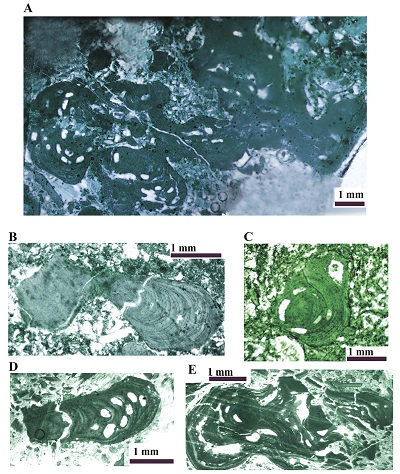 |
| Figure 7. Identified coralline red algae in the grainstone facies. (A) Lumpy growth form of Lithothamnion cf. rovereoti. (B) Fragment of a fruticose thallus of Lithothamnion sp.; partially abraded. (C) Fragment of fruticose thalli of Lithothamnion cf. peleense. (D) Fruticose thallus of Lithothamnion sp. (E) Foliose thalli of Lithothamnion sp. |
The co-occurrence of melobesioids (Lithothamnion), mastophoroids (Neogoniolithon, Spongites), and Sporolithon may be representative of the basinward part of the shoal environment, although a number of these algae could have been reworked and transported in the shoal environment.
Usually, the occurrence of coralline red algae in a grainstone facies is related to nutrient influx due to encroachment of siliciclastics (Erlich et al., 1990, 1993; Roozpeykar et al., 2019a). For instance, Ghosh and Sarkar (2013) have reported a grainstone facies comprising an algal association of Corallina, Lithothamnion, and Spongites from Pliocene reef and back-reef shelf environments as well as a melobesioid coralline algal assemblage of Phymatolithon, Mesophyllum, and Lithothamnion from a coralline algal boundstone in a Pliocene fore-reef environment. Roozpeykar et al. (2019a, 2019b) have studied a coralline red algae-rich grainstone in a Miocene shoal environment in the Zagros Basin and have reported non-geniculate (dominant Spongites and reworked melobesioids) and geniculate algae (Corallina).
Generally, coralline red algae were one of the major and most abundant’biotic components of photozoan and heterozoan communities of Oligocene–Miocene cool waters (non-tropic) and tropical carbonates (Bassi and Nebelsick, 2010; Braga et al., 2010). Mastophoroids (specifically Spongites) are common in shallow tropical carbonates (Adey et al., 1982; Braga and Aguirre, 2001, 2004), but are also present in subtropical and temperate environments. Some genera (e.g. Lithothamnion and Mesophyllum) of the subfamily Melobesioideae occur in both temperate and warm conditions (Braga and Aguirre, 2001; Halfar and Mutti, 2005; Bassi et al., 2009; Braga et al., 2010; Brandano and Piller, 2010; Rösler et al., 2015; Roozpeykar et al., 2019a, 2019b). Also, sporolithaceans (Sporolithon) are common in tropical deposits (Brandano et al., 2005). Coralline red algae can survive in different trophic conditions ranging from oligotrophic to mesotrophic environments in different latitudes (Braga et al., 2010). The main paleoecological factors controlling their growth and development in benthic marine environments include depth, hydrodynamic energy, chemical composition, light intensity, and temperature of marine waters (Sarkar, 2017). The different growth forms of coralline red algae are useful tools in paleoecological interpretation of marine carbonate facies (Bosence and Pedley, 1982; Braga and Martín, 1988; Braga and Aguirre, 2001; Rasser and Piller, 2004; Brandano et al., 2005; Brandano and Ronca, 2014) and include warty, lumpy, fruticose, foliose, encrusting, layered (non-geniculate), and arborescent (geniculate) (Woelkerling et al., 1993; Nebelsick and Bassi, 2000).
As evidenced in this study, the dominance of coralline red algae with fruticose growth forms (Table 1) in the shoal carbonate environment is consistent with high water energy (Bosence, 1991; Basso, 1998; Nebelsick et al., 2000). Agitation in the shoal environment, resulted different taphonomic features such as high fragmentation, disarticulation, and abrasion of several algae (Nebelsick et al., 2000; Nebelsick and Bassi, 2000; Roozpeykar et al., 2019a, 2019b). The identified algae (Table 1 and Figures 5–8) and the presence of larger benthic foraminifera point to a well-illuminated euphotic marine zone (Vescogni et al., 2014; Roozpeykar et al., 2019a, 2019b). The overall recognition of algae indicates that the Lower Miocene grainstone was deposited in warm tropical to subtropical waters (Bosence, 1983a, 1983b; Braga and Aguirre, 2001; Brandano et al., 2005; Roozpeykar et al., 2019a). Moreover, tropical conditions can be inferred owing to the presence of skeletal grains of corals and larger benthic foraminifera such as miliolids, Amphistegina, and Nephrolepidina in the studied grainstone facies (Pomar et al., 2004; Brandano et al., 2009; Roozpeykar et al., 2019a, 2019b).
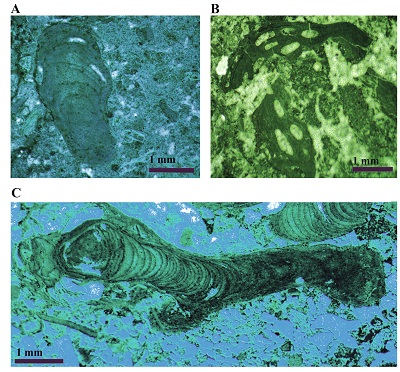 |
| Figure 8. Identified coralline red algae in the grainstone facies. (A) Fragment of a fruticose thallus of Lithothamnion sp. (B) Fragment of Lithothamnion sp. (encrusting growth form). (C) Melobesioid algae with a fruticose growth form. |
- Conclusions
The Lower Miocene (Aquitanian) algal-rich grainstone facies of the Qom Formation of Esfahan–Sirjan basin in central Iran is characterized by non-geniculate coralline red algae represented by melobesioids, mastophoroids, and sporolithaceans. The distribution of coralline red algae in the grainstone facies is probably linked to nutrient influx and the dominance of the fruticose growth form is indicative of high-energy conditions in a shoal environment. Due to the dominance of algae in well-illuminated waters, it may be concluded that the studied facies was deposited in the euphotic marine zone, and the Lower Miocene algal forms were inhabited in warm tropical to subtropical waters during the Aquitanian, having high-energy conditions, (i.e. increased hydrodynamic activity coupled with sediment agitation) that led to enhanced fragmentation, abrasion, and disarticulation of many algal forms recorded herein.
Contributions of authors
Amir Hossein Rahiminejad: conceptualization, analysis, and data acquisition, methodology, writing of the original manuscript, graphic design, fieldwork, interpretation, financing (applicant). Mehdi Yazdi: conceptualization, fieldwork. Amit Kumar Ghosh: correction and edition of the manuscript, contributed with paleontological interpretation and confirmation of fossil taxa.
Financing
This research was financially supported by the Institute of Science and High Technology and Environmental Sciences, Graduate University of Advanced Technology, Kerman, Iran, under grant number 524/98.
Acknowledgements
Dr. Amit Kumar Ghosh is highly indebted to the Director Birbal Sahni of the Institute of Palaeosciences, Lucknow for permission to carry out this collaborative work.
Conflicts of interest
The authors have no conflicts of interest to declare.
References
Aguirre, J., Riding, R., Braga, J.C., 2000, Diversity of coralline red algae: origination and extinction patterns from the Early Cretaceous to the Pleistocene: Paleobiology, 26(4), 651–667. https://doi.org/10.1666/0094-8373(2000)026<0651:docrao>2.0.co;2
Adey, W.H., Townsend, R.A., Boykins, W.T., 1982, The crustose coralline algae (Rhodophyta; Corallinaceae) of the Hawaiian Islands: Smithsonian Contributions to the Marine Sciences, 15, 1–74. https://doi.org/10.5479/si.01960768.15.1
Amirshahkarami, M., Karavan, M., 2015, Microfacies models and sequence stratigraphic architecture of the Oligocene-Miocene Qom Formation, south of Qom City, Iran: Geoscience Frontiers, 6(4), 593–604. https://doi.org/10.1016/j.gsf.2014.08.004
Bassi, D., Braga, J.C., Iryu, Y., 2009, Palaeobiogeographic patterns of a persistent monophyletic lineage: Lithophyllum pustulatum species group (Corallinaceae, Corallinales, Rhodophyta): Palaeogeography Palaeoclimatology Palaeoecology, 284, 237–245. https://doi.org/10.1016/j.palaeo.2009.10.003
Basso, D., 1998, Deep rhodolith distribution in the Pontian Islands, Italy: a model for the palaeoecology of a temperate sea: Palaeogeography Palaeoclimatology Palaeoecology, 137(1-2), 173–187. https://doi.org/10.1016/s0031-0182(97)00099-0
Bosence, D., 1983a, Description and classification of Rhodoliths (Rhodoids, Rhodolithes), in Peryt T.M. (ed.), Coated grains: Berlin, Springer, 217–224. https://doi.org/10.1007/978-3-642-68869-0_19
Bosence, D., 1983b, The occurrence and ecology of Rhodoliths (Rhodoids, Rhodolithes), in Peryt, T.M. (ed.), Coated grains: Berlin, Springer, 225–242. https://doi.org/10.1007/978-3-642-68869-0_20
Bosence, D.W.J., 1991, Coralline algae: mineralisation, taxonomy, and palaeoecology, in Riding, R. (ed.), Calcareous algae and stromatolites: Berlin, Springer, 98–113. https://doi.org/10.1007/978-3-642-52335-9_5
Bosence, D.W.J., Pedley, H.M., 1982, Sedimentology and palaeoecology of a Miocene coralline algal biostrome from the Maltese Islands: Palaeogeography Palaeoclimatology Palaeoecology, 38, 9–43. https://doi.org/10.1016/0031-0182(82)90062-1
Braga, J.C., 2003, Application of botanical taxonomy to fossil coralline algae (Corallinales, Rhodophyta): Acta Micropalaeontologica Sinica, 20, 47–56.
Braga, J.C., Aguirre, J., 2001, Coralline algal assemblages in upper Neogene reef and temperate carbonates in Southern Spain: Palaeogeography Palaeoclimatology Palaeoecology, 175(1), 27–41. https://doi.org/10.1016/s0031-0182(01)00384-4
Braga, J.C., Aguirre, J., 2004, Coralline algae indicate Pleistocene evolution from deep, open platform to outer barrier reef environments in the northern Great Barrier Reef margin: Coral Reefs, 23, 547–558. https://doi.org/10.1007/s00338-004-0414-x
Braga, J.C., Bassi, D., Piller, W., 2010, Palaeoenviromental significance of Oligocene–Miocene coralline red algae – a review, in Mutti, M., Piller, W., Betzler, C. (eds.), Oligocene-Miocene carbonate systems: International Association of Sedimentologists, Special Publication, 42, 165–182.
Braga, J.C., Martín, J., 1988, Neogene coralline-algal growth-forms and their palaeoenvironments in the Almanzora River Valley (Almeria, SE Spain): Palaeogeography Palaeoclimatology Palaeoecology, 67(3), 285–303. https://doi.org/10.1016/0031-0182(88)90157-5
Brandano, M., Piller, W.E., 2010, Coralline algae, oysters and echinoids-a liaison in rhodolith formation from the Burdigalian of the Latium-Abruzzi Platform (Italy): International Association of Sedimentologists, Special Publication, 42, 149–164. https://doi.org/10.1002/9781118398364.ch9
Brandano, M., Ronca, S., 2014, Depositional processes of the mixed carbonate–siliciclastic rhodolith beds of the Miocene Saint- Florent Basin, northern Corsica: Facies, 60(1), 73–90. https://doi.org/10.1007/s10347-013-0367-z
Brandano, M., Tomassetti, L., Pedley, M., Matteucci, R., 2009, Heterozoan carbonates in oligotrophic tropical waters: the Attard member of the lower coralline limestone formation (Upper Oligocene, Malta): Palaeogeography Palaeoclimatology Palaeoecology, 274, 54–63. https://doi.org/10.1016/j.palaeo.2008.12.018
Brandano, M., Vannucci, G., Pomar, L., Obrador, A., 2005, Rhodolith assemblages from the lower Tortonian carbonate ramp of Menorca (Spain): environmental and paleoclimatic implications: Palaeogeography Palaeoclimatology Palaeoecology, 226 (3), 307–323. https://doi.org/10.1016/j.palaeo.2005.04.034
Coletti, G., Basso, D., Corselli, C., 2018, Coralline algae as depth indicators in the Sommiéres Basin (early Miocene, Southern France): Geobios, 51, 15–30. https://doi.org/10.1016/j.geobios.2017.12.002
Daneshian, J., Ramezani Dana, L., 2007, Early Miocene benthic foraminifera and biostratigraphy of the Qom Formation, Deh Namak, central Iran: Journal of Asian Earth Sciences, 29, 844–858. https://doi.org/10.1016/j.jseaes.2006.06.003
Dunham, R.J., 1962, Classification of carbonate rocks according to depositional textures, in Ham, W.E. (ed.), Classification of carbonate rocks: AAPG, 108–121.
Erlich, R.N., Barrett, S.F., Bai, J.G., 1990, Seismic and geologic characteristics of drowning events on carbonate platforms: AAPG Bulletin, 74, 1523–1537. https://doi.org/10.1306/44b4b068-170a-11d7-8645000102c1865d
Erlich, R.N., Longo, A.P., Hyare, S., 1993, Response of carbonate platform margins to drowning: evidence of environmental collapse, in Louks, R.G., Sarg, J.F. (eds), Carbonate sequence stratigraphy: Recent developments and applications: AAPG, Tulsa, 57, 241–266. https://doi.org/10.1306/m57579c9
Flügel, E., 2010, Microfacies of carbonate rocks, analysis interpretation and application: Berlin, Springer, 984 p. https://doi.org/10.1007/978-3-642-03796-2
Ghosh, A.K., 2002, Cenozoic coralline algal assemblage from southwestern Kutch and its importance in palaeoenvironment and palaeobathymetry: Current Science, 83 (2), 153–158.
Ghosh, A.K., Sarkar, S., 2013, Facies analysis and paleoenvironmental interpretation of Piacenzian carbonate deposits from the Guitar Formation of Car Nicobar Island, India: Geoscience Frontiers, 4, 755–764. https://doi.org/10.1016/j.gsf.2013.01.010
Halfar, J., Mutti, M., 2005, Global dominance of coralline red algal facies: a response to Miocene oceanographic events: Geology, 33, 481–484. https://doi.org/10.1130/g21462.1
Moosavizadeh, S.M.A., Zand-Moghadam, H., Rahiminejad, A.H., 2020, Palaeoenvironmental reconstruction and sequence stratigraphy of the Lower Cretaceous deposits in the Zagros belt, SW Iran: Boletín de la Sociedad Geológica Mexicana, 72 (2), A060919. https://doi.org/10.18268/bsgm2020v72n2a060919
Moradi, S., 2012, Study of Microfacies, depositional environment and diagenesis of the Qom Formation in Abgarm anticline, SE Chahriseh, NE Isfahan: Iran, University of Isfahan, MSc dissertation.
Nebelsick, J.H., Bassi, D., 2000, Diversity, growth forms and taphonomy: key factors controlling the fabric of coralline algae dominated shelf carbonates: Geological Society, London, Special Publications, 178, 89–107. https://doi.org/10.1144/gsl.sp.2000.178.01.07
Nebelsick, J.H., Bassi, D., Drobne, K., 2000, Microfacies analysis and interpretation of Lower Oligocene, Shallow-water carbonates (Gornji Grad Beds, Slovenia): Facies, 43 (1), 157–176. https://doi.org/10.1007/bf02536989
Pomar, L., Brandano, M., Westphal, H., 2004, Environmental factors influencing skeletal grain sediment associations: a critical review of Miocene examples from the western Mediterranean: Sedimentology, 51(3), 627–651. https://doi.org/10.1111/j.1365-3091.2004.00640.x
Rahiminejad, A. H., Hassani, M. J., 2016, Paleoenvironmental distribution patterns of orbitolinids in the Lower Cretaceous deposits of eastern Rafsanjan, Central Iran: Marine Micropaleontology, 122, 53–66. https://doi.org/10.1016/j.marmicro.2015.11.006
Rahiminejad, A.H., Nouradini, M., Yazdi, M., 2017, Palaeoenvironmental analysis of scleractinian reef corals from the Oligo-Miocene Qom Formation in the Vartun section (northeastern Esfahan, central Iran): Historical Biology, 29(3), 384–394. https://doi.org/10.1080/08912963.2016.1167201
Rahiminejad, A.H., Yazdi, M., Ashouri, A.R., Kangazian, A., 2018, Siliciclastic input and sedimentation rate as controls on paleoecological distribution of Lower Miocene benthic carbonate producers in a fan–delta: Zagros foreland basin, Iran: Historical Biology, 30 (5), 608–626. https://doi.org/10.1080/08912963.2017.1312360
Rahiminejad, A.H., Yazdi, M., Bahrami, A., 2020, Palaeoenvironments and taphonomy of clypeasteroids in Miocene carbonates of the Esfahan–Sirjan Basin, central Iran: Facies, 66, 14. https://doi.org/10.1007/s10347-020-00598-6
Rahiminejad, A.H., Zand-Moghadam, H., 2018, Synsedimentary formation of ooidal ironstone: An example from the Jurassic deposits of SE central Iran: Ore Geology Reviews, 95, 238–257. https://doi.org/10.1016/j.oregeorev.2018.02.028
Rasser, M., Piller, W., 2004, Crustose algal frameworks from the Eocene Alpine foreland: Palaeogeography Palaeoclimatology Palaeoecology, 206, 21–39. https://doi.org/10.1016/j.palaeo.2003.12.018
Reuter, M., Piller, W.E., Harzhauser, M., Mandic, O., Berning, B., Rögl, F., Kroh, A., Aubry, M.P., Wielandt-Schuster, U., Hamedani, A., 2009, The Oligo– Miocene Qom Formation (Iran): evidence for an early Burdigalian restriction of the Tethyan Seaway and closure of its Iranian gateways: International Journal of Earth Sciences, 98(3), 627–650. https://doi.org/10.1007/s00531-007-0269-9
Rösler, A., Pretković, V., Novak, V., Renema, W., Braga, J.C., 2015, Coralline Algae from the Miocene Mahakam delta (East Kalimantan, Southeast Asia): Palaios, 30(1), 83–93. https://doi.org/10.2110/palo.2013.055
Roozpeykar, A., Maghfouri-Moghaddam, I., Yazdi, M., Yousefi-Yegane, B., 2019a, Paleontology and paleoecology of coralline algal assemblages from the Early–Middle Miocene deposits in NW of the Zagros basin, Iran: Carbonates and Evaporites, 34, 1595–1618. https://doi.org/10.1007/s13146-019-00509-z
Roozpeykar, A., Maghfouri-Moghaddam, I., Yazdi, M., Yousefi-Yegane, B., 2019b, Facies and paleoenvironmental reconstruction of Early- Middle Miocene deposits in the north-west of the Zagros Basin, Iran: Geologica Carpathica, 70(1), 75–87. https://doi.org/10.2478/geoca-2019-0005
Sadeghi, R., Vaziri-Moghaddam, H., Taheri, A., 2011, Microfacies and sedimentary environment of the Oligocene sequence (Asmari Formation) in Fars sub-basin, Zagros Mountains, southwest Iran: Facies, 57, 431–446. https://doi.org/10.1007/s10347-010-0245-x
Sarkar, S., 2017, Ecology of coralline red algae and their fossil evidences from India: Thalassas, 33, 15–28.
Sarkar, S., Ghosh, A. K., 2015, Evaluation of coralline algal diversity from the Serravallian carbonate sediments of Little Andaman Island (Hut Bay), India: Carbonates and Evaporites, 30(1), 13–24. https://doi.org/10.1007/s13146-014-0190-9
Sarkar, S., Ghosh, A.K., Narasimha, Rao, G.M., 2016, Coralline algae and benthic foraminifera from the Long Formation (middle Miocene) of the Little Andaman Island, India: Biofacies analysis, systematics and palaeoenvironmental implications: Journal of the Geological Society of India, 87, 69–84. https://doi.org/10.1007/s12594-016-0375-z
Sedorko, D., Bosetti, E.P., Netto, R.G., 2018, An integrative ichnological and taphonomic approach in a transgressive–regressive cycle: a case study from Devonian of Paraná Basin, Brazil: Lethaia, 51(1), 15–34. https://doi.org/10.1111/let.12219
Seyrafian, A., Toraby, H., 2005, Petrofacies and sequence stratigraphy of the Qom Formation (Late Oligocene- early Miocene?), north of Nain, southern trend of central Iranian basin: Carbonates and Evaporites, 20, 82–90. https://doi.org/10.1007/bf03175451
Stöcklin, J., Setudehina, A., 1991, Stratigraphic lexicon of Iran: Geological Survey of Iran Report, 18, 376 p.
Vescogni, A., Bosellini, F.R., Cipriani, A., Gürler, G., Ilgar, A., Paganelli, E., 2014, The Dağpazarı carbonate platform (Mut Basin, Southern Turkey): facies and environmental reconstruction of a coral reef system during the Middle Miocene Climatic Optimum: Palaeogeography Palaeoclimatology Palaeoecology, 410, 213–232. https://doi.org/10.1016/j.palaeo.2014.05.040
Vinn, O., Wilson, M.A., 2013, An event bed with abundant Skolithos burrows from the late Pridoli (Silurian) of Saaremaa (Estonia): Carnets de Géologie [Notebooks on Geology], Brest, Letter, 83–87. https://doi.org/10.4267/2042/49316
Woelkerling, W.J., Irvine, L.M., Harvey, A.S., 1993, Growth-forms in Non-geniculate Coralline Red Algae (Corallinales, Rhodophyta): Australian Systematic Botany, 6, 277–293. https://doi.org/10.1071/sb9930277
Yazdi, M., Shirazi Parvanenejad, M., Rahiminejad, A.H., Motavalipoor, R., 2012, Paleobathymetry and paleoecology of colonial corals from the Oligocene–Early Miocene (?) Qom Formation (Dizlu area, central Iran): Carbonates and Evaporites, 27, 395–405. https://doi.org/10.1007/s13146-012-0122-5
Yazdi-Moghadam, M., 2011, Early Oligocene larger foraminiferal biostratigraphy of the Qom Formation, South of Uromieh (NW Iran): Turkish Journal of Earth Sciences, 20, 847–856. https://doi.org/10. 3906/yer-0910-6
Zabihi Zoeram, F., Vahidinia, M., Sadeghi, A., Amiri Bakhtiar, H., Mahboubi, A., 2014, Palaeoenvironmental reconstruction based on coralline red algal and foraminifera assemblages in Oligo-Miocene succession of NW central Zagros, Iran: Revue de Paléobiologie, Genève. 33(2), 583–591.
Zahedi, M., 1978, Esfahan. Geological quadrangle map of Iran, No. J7. Ministry of Industry and Mines and Geological Survey of Iran. Scale: 1:250 000.
Zágoršek, K., Yazdi, M., Bahrami, A., 2017, Cenozoic cyclostomatous bryozoans from the Qom Formation (Chahriseh area northeast of Isfahan, central Iran): Neues Jahrbuch für Geologie und Paläontologie, 283(1), 109–118. https://doi.org/10.1127/njgpa/2017/0631

